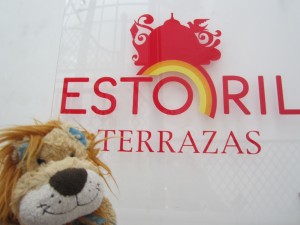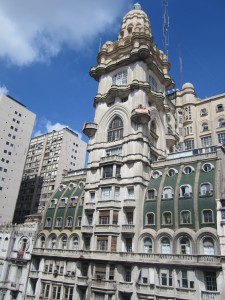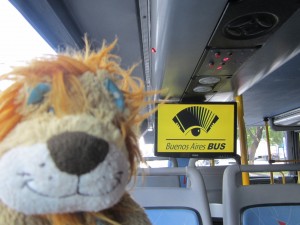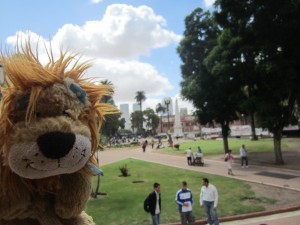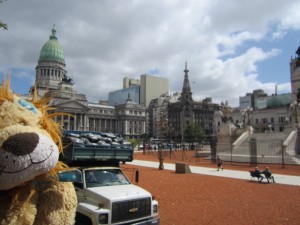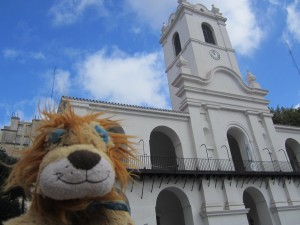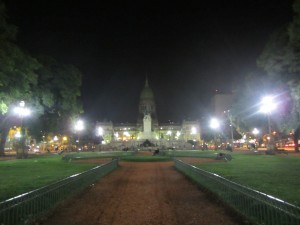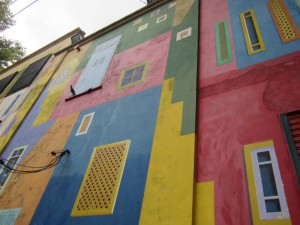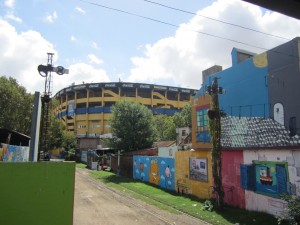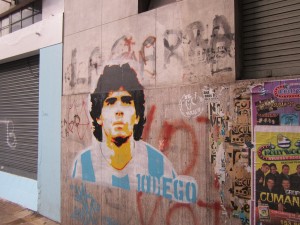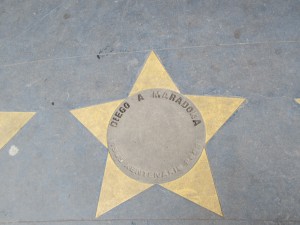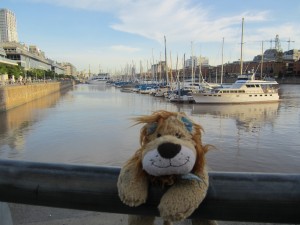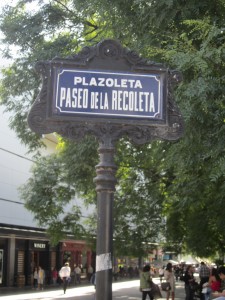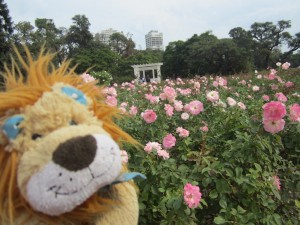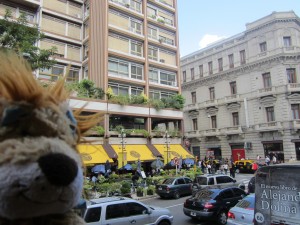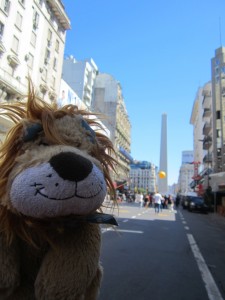After a couple of days, Lewis the Lion went to stay in some new accommodation. He could forget the fancy four-star hotel in the centre: it was time to live like a proper back-backer again and stay in a dormitory with other interesting people from all over the world! Luckily for him though, this accommodation, Estoril Terrazas, just turned out to be perfect as it was still in a central location on the famous Avenida de Mayo which led directly from Congress to Parliament in the Plaza de Mayo.
Furthermore, this youth hostel had a roof-top terrace from where you could watch the world go by and there was certainly a lot of life to watch in Buenos Aires!
This accommodation was a great base for Lewis the Lion to explore the city and he could quite easily walk for miles on any given day. However, he decided that perhaps the best way to truly get a feel or understanding for the city was to take a city bus-tour. This was a great way of giving him an overview of what the city had to offer and introduce him to some of the different neighbourhoods of Buenos Aires, especially as you could hop-on and hop-off the bus at any of the given stops.
First of all, there was the central district or the “Monserrat barrio“. “Barrio” is the Spanish word for neighbourhood and Lewis the Lion discovered that Buenos Aires offered very distinctive neighbourhoods. In the Monserrat barrio, lies the famous square of La Plaza de Mayo and it lies at the heart of political life in Argentina. (It was so named after Argentina gained independence from Spain on 25th May 1810).
In the background you can see a pink building called quite aptly, La Casa Rosada – the Pink House which is Argentina’s Parliament.
The Plaza de Mayo is flanked by many important buildings such as the National Bank of Argentina and here you can see the Metropolitan Cathedral of Buenos Aires which looks a bit like a Greek temple with a domed roof.
On the opposite side of the square to the Casa Rosada, Lewis learnt about the former town hall in colonial times, el Cabilito, which is now a museum.
The bus then drove up the beautiful tree-lined avenue of Avenida de Mayo right past where Lewis was staying towards the Congress building. Lewis thought that it was particularly beautiful at night when it was lit up.
On the bus, Lewis the Lion and Helen could listen into a guided tour through some headphones as they passed through the various districts. It was clever because you could select the right language to listen into with a choice of 9 different languages! All of a sudden their ears were then filled with the distinctive sound of tango music. That was because they were passing through the district of San Telmo. San Telmo is said to be the area where tango music and then tango dancing first developed at the end of the 19th Century as many immigrants from all over the world converged into tightly packed houses, bringing with them the rhythms and music from their own countries. You can listen to some tango music on the video clip below when Lewis the Lion visits the next area: the bright and colourful La Boca. (Lewis the Lion will write about Tango in more detail in another blog entry).
La Boca is quite a run-down neighbourhood but its famous football stadium – La Bombonera, home to Club Atletico Boca Juniors or simply Boca Juniors, is a guaranteed crowd puller.
Many of the famous national Argentine football players have played for Boca Juniors, such as Diego Maradona and Carlos Tevez.
Diego Maradona, in particular is considered by many to be the greatest footballer of all time and in 1999, he won the FIFA player of the century award. It’s for this reason that his name appears on a star outside the football stadium and his image on many of the walls around the city of Buenos Aires.
Do you have a favourite football player or sportsman or woman? Who is it? Why do you like them and how do they inspire you?
The football stadium isn’t the only draw to the La Boca district. It is steeped in history thanks to its mainly Italian immigrants who arrived in Buenos Aires in the late 19th Century. Their influence is evidenced in its artwork, culture and brightly coloured buildings.
There are sometimes impromptu performances of tango which you can watch whilst walking around. Click on this clip to see more.
The next neighbourhood for the bus to pass through was Puerta Madera. This is the port area of Buenos Aires and to Lewis the Lion it looked like it had been regenerated into a very chique area of town with smart cafe bars, restuarants, posh hotels and even a floating casino!
The bus then continued down to another distinctive area of town: Recoleta. Lewis the Lion learnt that this was the home to some fabulous museums but also a very special cemetery which he will talk about in a future blog entry.
Travelling along the long, straight road of Avenida del Libertador, Lewis the Lion then passed through the smart district of Palermo, with its coffee bars and wonderful parks.
He also drove past other culturally important places there: the Argentine Polo Field and the Argentine Hippodrome. The game of polo and horse-racing play a big part in Argentine culture and Lewis the Lion hoped he would be lucky enough to see some polo during his stay in Buenos Aires. He would keep his fingers crossed!
Before the tour bus started to make its way back to the city centre, Lewis was starting to feel as hungry as a lion! Therefore, he stopped at a rather special place for lunch in another neighbourhood which made him feel like he was a million miles from Buenos Aires. The area is called Barrio Chino and it is where Buenos Aires’ China Town is located.
Lewis the Lion was pleased to be greeted by another lion at the entrance to a beautifully decorated Chinese archway
and not far away, he discovered a restaurant called La Gran Muralla Chino – The Great Wall of China.
Lewis laughed as Helen wasn’t so good at using chopsticks as she ate her meal of rice, chicken and vegetables!
Finally, the bus tour took Lewis the Lion back towards the centre and the area of San Nicolas. Here he could see the elegant theatre, Teatro Colón and also the eye-catching Obelisk from which many famous streets seemed to radiate out.
Lewis the Lion felt thoroughly exhausted by the time he stepped off the city bus to go back to his hostel. He had seen so much of Buenos Aires and now felt that he had identified places which he would like to go back to and explore more.
If you were visiting Buenos Aires, which “barrio” or neighbourhood would you most like to visit? Why?

